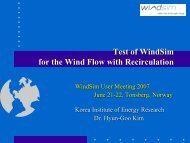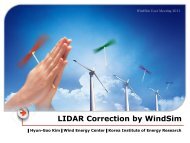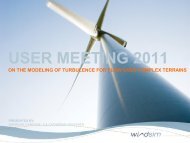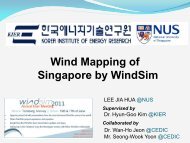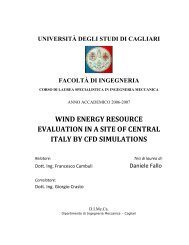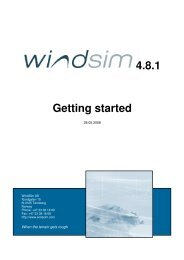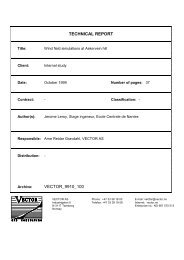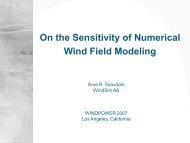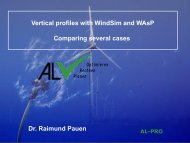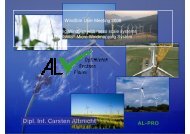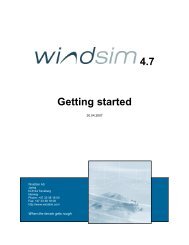Wind in complex terrain. A comparison of WAsP and two ... - WindSim
Wind in complex terrain. A comparison of WAsP and two ... - WindSim
Wind in complex terrain. A comparison of WAsP and two ... - WindSim
- No tags were found...
You also want an ePaper? Increase the reach of your titles
YUMPU automatically turns print PDFs into web optimized ePapers that Google loves.
4 ResultsThe CFD-models are <strong>in</strong>itialized based on assumptionsabout higher level (~500m) <strong>and</strong> lateral boundary levelw<strong>in</strong>d speed <strong>and</strong> pr<strong>of</strong>iles. A logarithmic w<strong>in</strong>d pr<strong>of</strong>ile(correspond<strong>in</strong>g to neutral stability conditions) isemployed at the boundaries <strong>in</strong> both models. Thus, <strong>in</strong>order to compare the output <strong>of</strong> the CFD-models withany measurements, the modeled w<strong>in</strong>d speed fieldshave to be scaled by use <strong>of</strong> the measurements. Forexample, for a specific annual w<strong>in</strong>d speed from sectorS at 50 m at one <strong>of</strong> the sites, the output <strong>of</strong> the CFDmodelwill be assumed equal to the measurement atthis site. It is then further assumed that the w<strong>in</strong>d fieldcan be scaled l<strong>in</strong>early based on the scal<strong>in</strong>g at thisparticular site. By employ<strong>in</strong>g this method modelsimulations <strong>of</strong> the w<strong>in</strong>d speed at all the measur<strong>in</strong>gsites can be obta<strong>in</strong>ed. Thus it is assumed that the ratio<strong>of</strong> the modeled <strong>and</strong> measured values at one site willapply to the whole model<strong>in</strong>g doma<strong>in</strong>. Thisassumption may not be valid everywhere <strong>in</strong> themodel<strong>in</strong>g doma<strong>in</strong>, but it is quite commonly applied tomodel<strong>in</strong>g. In the follow<strong>in</strong>g section we assess themodel simulations by us<strong>in</strong>g this method. The CFDmodelsare scaled to yield correct w<strong>in</strong>d speed at the50 m level at Site 2 <strong>and</strong> Site 3 respectively, then theresults at the other measur<strong>in</strong>g sites are extracted fromthe CFD-models.The <strong>WAsP</strong> model work differently. In order tomake the results from <strong>WAsP</strong> comparable to the CFDmodels,the measurements at 50 m from Site 2 <strong>and</strong>Site 3 are <strong>in</strong>serted <strong>in</strong> the model <strong>and</strong> the w<strong>in</strong>d speed <strong>of</strong>the other measur<strong>in</strong>g mast are obta<strong>in</strong>ed for the samesectors as utilized by the CFD-models.Note that the CFD-models were run only for the<strong>two</strong> sectors north (N) <strong>and</strong> south (S) to savecomputational efforts. Each sector covers 30°centered around 360° <strong>and</strong> 180° respectively.Accord<strong>in</strong>g to the w<strong>in</strong>d rose (see Figure 2), thedirections N <strong>and</strong> S represent ca. 13% <strong>and</strong> 18% <strong>of</strong> thew<strong>in</strong>d data respectively.4.1 Annual average w<strong>in</strong>d speedIn Figure 3 the vertical pr<strong>of</strong>iles at site 2 have beenobta<strong>in</strong>ed based on a “true” solution at 50 m height atsite 3. For the southerly sector the w<strong>in</strong>d direction isnearly perpendicular to the steep slope to the south <strong>of</strong>site 2 <strong>and</strong> a strong speed-up is encountered. Both<strong>W<strong>in</strong>d</strong>Sim <strong>and</strong> <strong>WAsP</strong> yield only small differencesfrom the observations, while 3D<strong>W<strong>in</strong>d</strong> yields a largeoverestimation <strong>of</strong> the w<strong>in</strong>d speed. For the northerlysector, the w<strong>in</strong>d speed actually decreases from 10 mto 50 m at site 2. All three models underestimate thew<strong>in</strong>d speed for this sector, still <strong>WAsP</strong> yields the bestresults <strong>in</strong> this particular case.A further <strong>comparison</strong> <strong>of</strong> the output <strong>of</strong> the modelsimulations with the observations has been carried out. Thethree models are all scaled to fit the observations at 50 mheight at either site 2 or site 3.Based on the scaled values <strong>of</strong> each <strong>of</strong> the <strong>two</strong> sites,the annual average w<strong>in</strong>d speed is estimated at theother levels <strong>of</strong> the same mast (10m <strong>and</strong> 30m) <strong>and</strong>Height (m)Height (m)605040302010Site 2 - S (scaled at site 3 50m)00.00 0.50 1.00 1.50 2.00605040302010Scaled w<strong>in</strong>dspeedSite 2 - N (scaled at site 3 50m)00.00 0.50 1.00 1.50 2.00Scaled w<strong>in</strong>dspeedOBSWASPWINDSIM3D<strong>W<strong>in</strong>d</strong>OBSWASPWINDSIM3D<strong>W<strong>in</strong>d</strong>Figure 3. Scaled vertical pr<strong>of</strong>iles at Site 2 for sector S(upper panel) <strong>and</strong> sector N (lower panel).Modelled2.001.801.601.401.201.000.800.600.400.200.00Obs vs model Sector S0.00 0.20 0.40 0.60 0.80 1.00 1.20 1.40 1.60 1.80 2.00ObservedWasp WINDSIM 3D<strong>W<strong>in</strong>d</strong>




